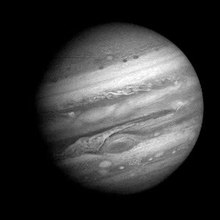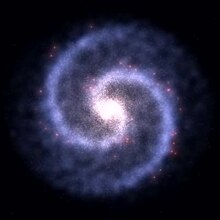Differential rotation
Of differential rotation ( Super rotation ) is used when the angular velocity of a rotating body / system depending on the latitude of the point or its distance from the rotational axis is different, so the body does not rotate at the same speed anywhere. This is not possible with solids .
A differential rotation is always associated with a shear .
Examples
General
For example, the surfaces of the Sun , Jupiter, and Saturn are in differential rotation. The regions close to the equator rotate noticeably faster than those in the area of the poles . Usually galaxies , accretion disks and protostars also have a differential rotation.
earth
The differential rotation between the earth's core and earth's mantle is assumed to be a result of currents through the geodynamo , which builds up the earth's magnetic field . This means that the super rotation is probably a consequence, but not the cause, of the geodynamos.
Our solar system
The solar system is an example of differential rotation : almost all mass is united in the central body - the sun - and the planets revolve around them in almost circular orbits (generally in Kepler orbits ). The Kepler's laws describe the motion, the closer a body is to the central mass, the faster (both web speed and angular velocity ) should he move when he wants to move in a constant / stable web. For these tracks we get:
- : Orbit speed
- : Gravitational constant
- : major semi-axis / radius
- : Solar mass (planetary mass negligible compared to )
with follows:
- : Angular velocity
So it results:
The rotation of the sun and the gas planets
The equatorial regions of the sun and the gas planets have a shorter period of rotation than the poles.
The reason is probably that the celestial bodies are not rigid and that the angular momentum is pushed into the regions with the largest radius due to thermal processes, because all matter that moves faster than average due to thermal movements in the direction of rotation is simultaneously higher Centrifugal forces pushes outwards.
the Milky Way
In 1927, the Dutch astronomer Jan Hendrik Oort showed that our galaxy, the Milky Way , is in differential rotation: the stars near the center have a higher angular velocity than those in the outer regions ( rotation curve , Oort rotation formula ).
Conclusions about the mass distribution of a galaxy can be drawn from the orbital speeds using Newton's law of gravity . It shows that the orbital velocities within a galaxy do not decrease towards the outside, which would be assumed based on the distribution of visible matter, in some galaxies they even increase slightly. The differences between observed orbital speeds and calculated values ultimately led to the assumption that there must be another form of matter besides the visible, the unobservable dark matter .
Another theory tries to explain this difference by modifying Newton's law of motion (so-called modified Newtonian dynamics ).
literature
- Günther Rüdiger : Differential rotation and stellar convection - sun and solar-type stars. Gordon and Breach, New York 1989, ISBN 2-88124-066-6
- Hans C. Zebedin: New attempts to determine the differential rotation of filaments. Diss., Univ. Graz 1993











